Related Research Articles
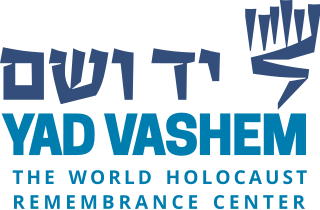
Yad Vashem is Israel's official memorial to the victims of the Holocaust. It is dedicated to preserving the memory of the Jews who were murdered; echoing the stories of the survivors; honoring Jews who fought against their Nazi oppressors and gentiles who selflessly aided Jews in need; and researching the phenomenon of the Holocaust in particular and genocide in general, with the aim of avoiding such events in the future. Yad Vashem's vision, as stated on its website, is: "To lead the documentation, research, education and commemoration of the Holocaust, and to convey the chronicles of this singular Jewish and human event to every person in Israel, to the Jewish people, and to every significant and relevant audience worldwide."

Henekh "Henry" Morgentaler, was a Polish-born Canadian physician and abortion rights advocate who fought numerous legal battles aimed at expanding abortion rights in Canada. As a Jewish youth during World War II, Morgentaler was imprisoned at the Łódź Ghetto and later at the Dachau concentration camp.
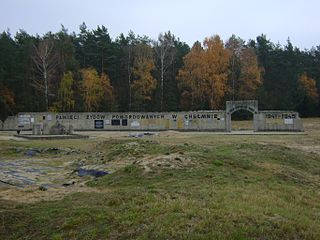
Chełmno or Kulmhof was the first of Nazi Germany's extermination camps and was situated 50 km (31 mi) north of Łódź, near the village of Chełmno nad Nerem. Following the invasion of Poland in 1939, Germany annexed the area into the new territory of Reichsgau Wartheland. The camp, which was specifically intended for no other purpose than mass murder, operated from December 8, 1941, to April 11, 1943, parallel to Operation Reinhard during the deadliest phase of the Holocaust, and again from June 23, 1944, to January 18, 1945, during the Soviet counter-offensive. In 1943, modifications were made to the camp's killing methods as the reception building had already been dismantled.

Chava Rosenfarb was a Holocaust survivor and Jewish-Canadian author of Yiddish poetry and novels, a major contributor to post-World War II Yiddish Literature.

The Holocaust had a deep effect on society both in Europe and the rest of the world, and today its consequences are still being felt, both by children and adults whose ancestors were victims of this genocide.
A Page of Testimony is a form issued by Yad Vashem that asks for information about a Jewish victim of the Holocaust. Over 4.3 million Pages of Testimony have been submitted to Yad Vashem, beginning in the 1950s. Most of these, as well as other forms of documentation of Holocaust victims, are searchable and viewable online through Yad Vashem's Central Database of Shoah Victims' Names.

Irena Adamowicz, was a Polish-born scout leader and a resistance member during World War II. She was a courier for the underground Home Army. In 1985, Adamowicz was posthumously bestowed the title of the Righteous Among the Nations by Yad Vashem in Jerusalem for her activities involving providing information to a number of Jewish ghettos in occupied Poland.
Rywka Lipszyc was a Polish-born Jewish diarist and Holocaust survivor. She was deported to Auschwitz-Birkenau concentration camp followed by a transfer to Gross-Rosen and forced labor at its subcamp in Christianstadt. She was then taken on a death march to Bergen-Belsen, and was liberated there in April 1945. Too ill to be evacuated, she was transferred to a hospital at Niendorf, where the record of her life ended.

The Stolpersteine in Prague-Josefov lists the Stolpersteine in the town quarter Josefov of Prague, the former Jewish quarter of the city. Stolpersteine is the German name for stumbling blocks collocated all over Europe by German artist Gunter Demnig. They remember the fate of the Nazi victims being murdered, deported, exiled or driven to suicide.
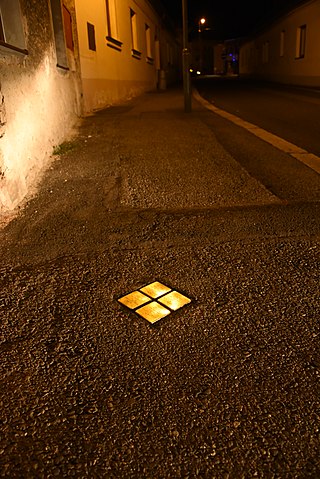
The Stolpersteine in the Plzeňský kraj lists the Stolpersteine in the Plzeň Region in the western part of Bohemia. Stolpersteine is the German name for stumbling blocks collocated all over Europe by German artist Gunter Demnig. They remember the fate of the Nazi victims being murdered, deported, exiled or driven to suicide.

This is a list of Stolpersteine in the Holešovice district of Prague. Stolpersteine is the German name for stumbling blocks collocated all over Europe by German artist Gunter Demnig. They commemorate the fate of the Nazi victims who were murdered, deported, exiled or driven to suicide.
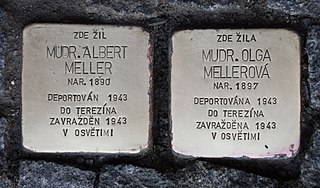
The Stolpersteine in the Pardubický lists the Stolpersteine in the Pardubice Region in the east of Bohemia. Stolpersteine is the German name for stumbling blocks collocated all over Europe by German artist Gunter Demnig. They remember the fate of the Nazi victims being murdered, deported, exiled or driven to suicide.
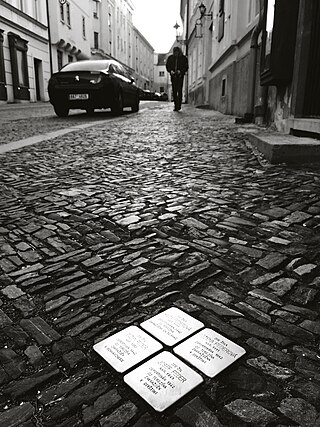
The Stolpersteine in Kolín lists the Stolpersteine in the town of Kolín in the Central Bohemian Region. Stolpersteine is the German name for stumbling blocks collocated all over Europe by German artist Gunter Demnig. They remember the fate of the Nazi victims being murdered, deported, exiled or driven to suicide.

The Stolpersteine in the Moravskoslezský kraj lists the Stolpersteine in the Moravian-Silesian Region in the easternmost part of Moravia. Stolpersteine is the German name for stumbling blocks collocated all over Europe by German artist Gunter Demnig. They remember the fate of the Nazi victims being murdered, deported, exiled or driven to suicide.
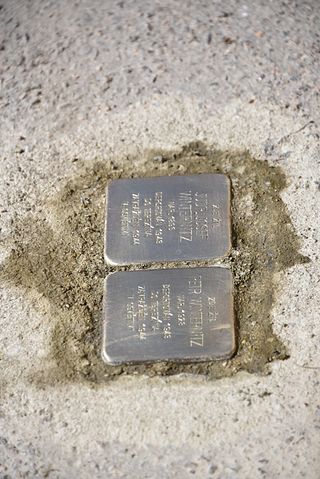
The Stolpersteine in Prague-Smíchov lists the Stolpersteine in the district Smíchov of Prague. Since 2002, the district belongs to Praha 5. Stolpersteine is the German name for stumbling blocks collocated all over Europe by German artist Gunter Demnig. They remember the fate of the Nazi victims being murdered, deported, exiled or driven to suicide.
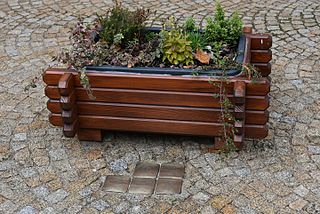
The Stolpersteine in Lomnice u Tišnova lists the Stolpersteine in the town Lomnice in the South Moravian Region. Stolpersteine is the German name for stumbling blocks collocated all over Europe by German artist Gunter Demnig. They remember the fate of the Nazi victims being murdered, deported, exiled or driven to suicide.

The Stolpersteine in Tišnov lists the Stolpersteine in the town Tišnov in the South Moravian Region. Stolpersteine is the German name for stumbling blocks collocated all over Europe by German artist Gunter Demnig. They remember the fate of the Nazi victims being murdered, deported, exiled or driven to suicide.

The list of stolpersteine in Prague-Břevnov, Bubeneč and Dejvice contains the stumbling blocks that were placed in the Prague district of Břevnov and Bubeneč as well as in the cadastral district of Dejvice. Břevnov has partially belonged to Prague since 2002, Dejvice is entirely part of Prague 6. Bubeneč was divided between Prague 6 and Prague 7. The stumbling blocks remind and make aware of the fate of the people who were murdered, deported, expelled or driven into suicide by the national socialists. The Stolpersteine were designed and placed by Gunter Demnig.

The Stolpersteine in Říčany lists the Stolpersteine in the town of Říčany. Stolpersteine is the German name for stumbling blocks collocated all over Europe by German artist, Gunter Demnig. The blocks commemorate the Nazi victims that were murdered, deported, exiled, or driven to suicide.

The Stolpersteine in Loštice lists the Stolpersteine in the town Loštice, Czech Republic. Stolpersteine is the German name for stumbling blocks collocated all over Europe by German artist Gunter Demnig. They remember the fate of the Nazi victims being murdered, deported, exiled or driven to suicide.
References
- ↑ The Central Database of Shoah Victims' Names Website Yad Vashem The Holocaust Martyrs' and Heroes' Remembrance Authority
- ↑ "World Family Names" Part of the website PublicProfiler